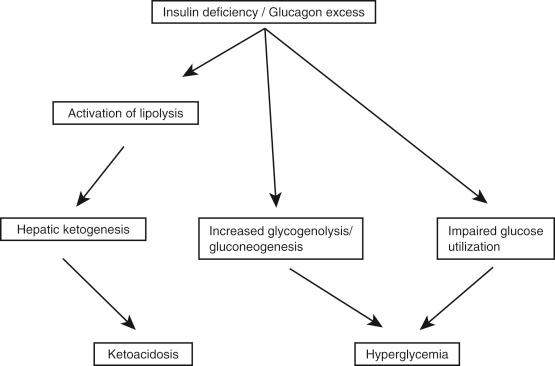Physical Address
304 North Cardinal St.
Dorchester Center, MA 02124
A 75-year-old woman with type 2 diabetes mellitus, controlled by glyburide 5 mg twice a day, presents for scheduled coronary artery bypass grafting. She has diabetic nephropathy with a serum creatinine of 1.8 mg/dL. The patient did not take her oral antidiabetic medication before surgery, and her fasting plasma glucose was 130 mg/dL. After cardiopulmonary bypass, the intraoperative plasma glucose was 236 mg/dL. There was a brisk diuresis. The serum potassium was 5.8 mEq/L with a base deficit of −4.0 mEq/dL. The patient received furosemide and mannitol while on cardiopulmonary bypass and repeated doses of cardioplegia. Cardiopulmonary bypass took 130 minutes.
Hyperglycemia in adults is defined as a random plasma glucose level greater than 200 mg/dL. It is generally accepted that prevention of uncontrolled hyperglycemia is appropriate, although the optimal blood glucose range remains debated. Perioperative plasma glucose levels are determined by many factors, including preoperative glucose, nutritional status, and insulin levels and increased cortisol, catecholamines, glucagon, growth hormone, gluconeogenesis, and glycogenolysis.
At times of illness or acute severe stress, hyperglycemia may be present; this is referred to as stress hyperglycemia or stress diabetes. In some patients this may reflect the unmasking of an abnormality of glucose tolerance, which should be treated to reduce the risk of increased morbidity and mortality. The patient should subsequently be reevaluated and reclassified after recovering from surgery or acute illness. A similar approach is used in the management of gestational diabetes.
Diabetes mellitus (DM), the most common endocrine disease, is a chronic multisystem disease heralded by signs and symptoms of persistent hyperglycemia and confirmed by a random plasma glucose level greater than 200 mg/dL, a fasting plasma glucose level greater than 100 mg/dL, a plasma glucose level of 140 mg/dL or greater based on 2-hour postprandial testing or 2 hours after an oral glucose tolerance test, or a random glucose of greater than 200 mg/dL. Normal values for plasma glucose are given in Table 144.1 . In the absence of acute metabolic decompensation or severe hyperglycemia, these criteria should be reconfirmed at least 24 hours apart. The diabetic patient population is heterogenous, and several diabetic syndromes have been defined. Hyperglycemia in diabetic patients is the result of either a relative or absolute deficiency of insulin and a relative or absolute excess of glucagon. In type 1 diabetes, there is an absolute deficiency in insulin production with an onset typically by adolescence and is thought to be a result of autoimmune destruction of islet cells in the pancreas. These patients become dependent on exogenous insulin to prevent lipolysis and eventually ketoacidosis. Type 2 diabetes is heralded by a relative deficiency in insulin and is more a manifestation of insulin resistance. Typical onset of type 2 diabetes is in adulthood, although data suggest the mean age is decreasing. Gestational diabetes is a third type that is defined by any degree of glucose intolerance with onset first recognized during pregnancy and complicates approximately 4% of all US pregnancies.
| Normal | High Risk for Diabetes | Diabetes |
|---|---|---|
| Fasting plasma glucose (FPG) <100 mg/dL | FPG ≥100–125 mg/dL | FPG ≥126 mg/dL |
| 2-h postprandial glucose (PG) <140 mg/dL | 2-h PG ≥140–199 mg/dL | 2-h PG ≥200 mg/dL Random plasma glucose ≥200 mg/dL + symptoms |
| HgbA1C <5.5% | 5.5%–6.4% | ≥6.5% |
Diabetic ketoacidosis (DKA) is an emergent condition usually associated with type 1 DM. It generally occurs in the setting of absent insulin, poor glucose utilization, and often some pathologic stressor (e.g., illness, infection, trauma). The body attempts to preserve energy stores via gluconeogenesis, which is the mobilization of fats and amino acids into glucose-producing pathways, resulting in hyperglycemia and ketosis ( Fig. 144.1 ).

Nonketotic hyperosmolar syndrome occurs in type 2 diabetics is often triggered by physiologic stress (e.g., illness, acute infection, pneumonia, stroke, myocardial infarction). Endogenous insulin is present in sufficient quantities to prevent these patients from developing ketoacidosis; however, they present with an anion gap metabolic acidosis secondary to lactic acidosis. This acid-base derangement occurs as a result of cellular hypoxia, likely due to hypovolemia, inadequate organ perfusion, or a shock state. Nonketotic hyperosmolar syndrome is characterized by severe hyperosmolarity (>320 mOsm/L), hyperglycemia (>600 mg/dL), and marked dehydration.
Become a Clinical Tree membership for Full access and enjoy Unlimited articles
If you are a member. Log in here